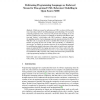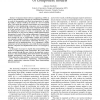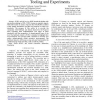MODELS
2015
Springer
8 years 7 months ago
2015
Springer
—Safety-critical Cyber-Physical Systems (CPS) are growing increasingly more distributed, autonomous, and embedded in our society. CPS engineering relies on modeling methods from ...
MODELS
2015
Springer
8 years 7 months ago
2015
Springer
Abstract. Models are means for unification and UML was born with the ambition of providing “unified” modelling language and methodology. The myriad of competing proprietary t...
MODELS
2015
Springer
8 years 7 months ago
2015
Springer
Abstract—A variety of tools today support the dynamic execution/simulation of models within a single modeling environment. However, they all suffer from limitations resulting fro...
MODELS
2015
Springer
8 years 7 months ago
2015
Springer
Abstract. In the last decade, there have been several fundamental advances in the field of ontological and linguistic metamodelling. They the use of megamodels to link abstract, d...
MODELS
2015
Springer
8 years 7 months ago
2015
Springer
Abstract. Over the last years, several repositories have been proposed in response to the need of the MDE community for advanced systems supporting the reuse of modeling artifacts,...
MODELS
2015
Springer
8 years 7 months ago
2015
Springer
—Modeling methods for Cyber-Physical Systems (CPS) originate in various engineering fields, and are difficult to use together due to their heterogeneity. Inconsistencies betwee...
MODELS
2015
Springer
8 years 7 months ago
2015
Springer
—Component-based software engineering (CBSE) is based on the fundamental concepts of components and bindings, i.e. units of decomposition and their interconnections. By adopting ...
MODELS
2015
Springer
8 years 7 months ago
2015
Springer
Abstract. We assess the use of several Eclipse-based Model-Driven Engineering technologies (e.g. EMF, GMF, Xtext, Sirius, ATL, QVTO, Epsilon) in open-source software development pr...
MODELS
2015
Springer
8 years 7 months ago
2015
Springer
—fUML and Alf are two OMG standards dealing with executable modeling in UML. fUML focuses on semantic aspects, while Alf focuses on syntax. Papyrus (the UML/SysML modeler of the ...
MODELS
2015
Springer
8 years 7 months ago
2015
Springer
Abstract—The Unified Modeling Language (UML) is a defacto standard for software development and, together with the Object Constraint Language (OCL), allows for a precise descrip...



